| Lista Light |  |
Exeter (Devon, England) to Fishguard (Wales)
VOYAGE LOG
The start of Lista Light’s journey from Exeter Canal to......the Isle of Eigg to.....the West Indies and beyond.....
Monday 21 July 2008
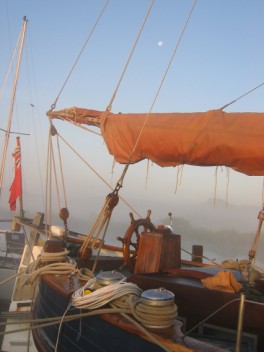
To start at the beginning, 6am, the dawn of our voyage, a blanket of mist wafts through the Exeter canal. Haldon ridge hangs above the glinting vapour in the golden first light. Swallows and house martins are gathering in a huge flickering flock. They wheel and dive and spin through the mist, plucking morsels from the air.
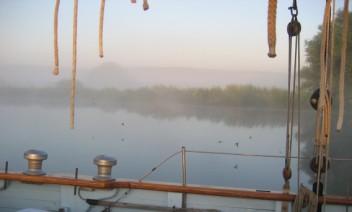
The Exe marshes are a fantastic fattening ground for hirundines with the clouds of flies that frequent its watery environs. As the days shorten and they start to think about heading south on their 5000 mile journey, these rich foraging grounds will be key to their survival. Small gangs gather on Lista Light and on the neighbouring boats, an appropriate leaving party for our avian-centric travels.
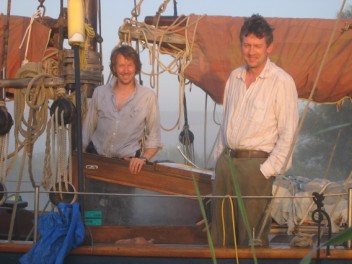
We zigzag through the estuary, a minefield of underwater bars, spits and banks ready to ground Lista. At low tide they’re revealed to the crowds of birds queuing in the mud who stab for invertebrates in one of the finest bird banqueting halls in the country. The Exe Estuary is a Special Protection Area of international important for wintering waders and wildfowl, with: avocets, black-tailed godwits, grey plovers, curlews and brent geese.
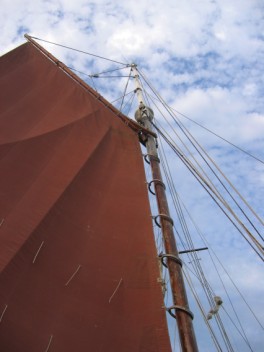
With sails up and a blue sky mirrored in the sea, we surge forwards. Devon’s sandstone cliffs melt past us on our red-brick way. Gazing at the mosaic of cliff tops I recognize the fields and valleys I stomped over as Cirl Bunting Project Officer for the RSPB. The cirl bunting is the UK’s rarest resident farmland bird. In the 1980s the population had declined to under 120 pairs, mainly found in Devon (they had previously occurred through much of southern England and into north Wales). Unlike generalist species which adapt to different habitats and food sources (e.g. Crows and foxes) specialist species such as the cirl bunting require specific conditions to survive.
Over the past forty years, changes in agriculture have reduced the amount of food and shelter in the countryside. The switch from spring to autumn corn has removed the seed-rich stubble ladders that were left over-winter. ‘Improvements’ in grass swards and the advent of silage has created grass ‘deserts’ void of life and diversity. Hedgerows were removed and rough areas of scrub tidied. All these moves were disastrous for the cirl bunting and other farmland birds, depriving them of winter and summer food and nesting habitat.
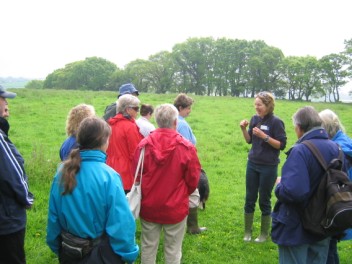
Thanks to the efforts of the RSPB and farmers, cirl bunting fortunes have turned, with c.700 pairs recorded in 2003. My job as the RSPB’s Cirl Bunting Officer was to continue the upwards trend, by increasing understanding in the species and to work with farmers to produce suitable habitat for it to recover whilst farming economically. At the same time, I surveyed other flora and fauna under the cirl bunting ‘umbrella’, ensuring that suitable habitat was present for a gamut of declining species such as horseshoe bats and rare arable flowers.
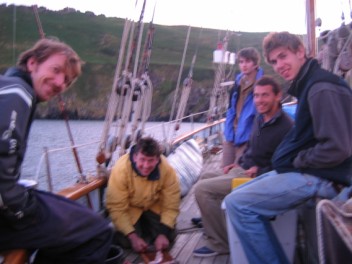
We anchor near Salcombe in a small bay by Bolt Head. Andy casts a lazy line into the water and the sun drops golden light over Lista. We dine on mackerel, dogfish and sea-water tatties under a star-pocked sky and drift into fat sleep on the first night of many at sea.
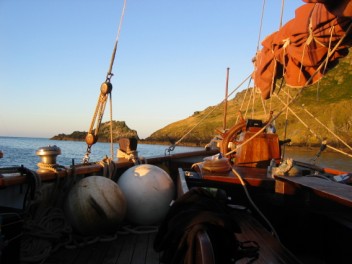
On our way, Hart, David and Tristan strum on the guitar and surprisingly dulcet tunes waft through the air. Next, the mouth organ and soft wailing... Ner’ a finer trio of Shakespearian minstrels have I clapped eyes on. Only to be completed with pleated skirts, ruffled collars and mulberry tights and I’m sure the very mer-maidens would rise from the deep and pluck their harps!
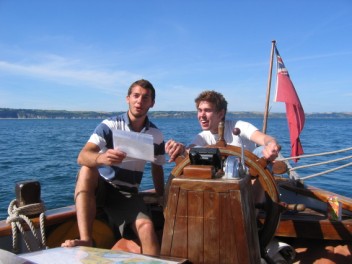
‘What shall we do with a drunken sailor’ bellows out from the helm as Tristan and David begin their term as the pirate entertainment. Meanwhile Andy climbs the ladder thinking himself a seasoned seadog. Indeed, who knows what may be lurking beneath us?
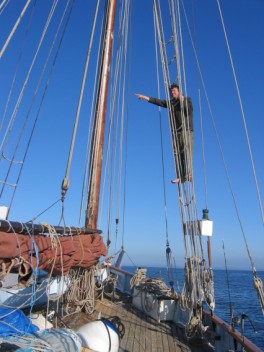
It’s 1817, Gloucester Bay, Massachusetts, a huge sea serpent is reported, ‘We counted twenty bunches (humps)..his head was of a dark brown colour, formed like a seal’s and shined with a glossy appearance..his head was large as a barrel for we could see it when he was about four miles from us.’
16th century Norwegian sailors told tales of a monstrous ‘Kraken’ emerging from the deep. It was capable of creating a whirlpool big enough to pull the largest ships to certain peril.
Tennyson, a poem from a collection in Juvenilia
‘Below the thunders of the upper deep,
Far, far beneath the abysmal sea,
His ancient, dreamless, uninvaded sleep
The Kraken sleepeth; faintest sunlights flee
About his shadowy sides; above him swell
Huge sponges of millennial growth and height;
And far away into the sickly light,
From many a wondrous grot and secret cell
Unnumber’d and enormous polypi
Winnow with giant arms the slumbering green.
There he hath lain for ages, and will lie
Battening upon huge sea-worms in his sleep,
Until the latter fire shall heat the deep;
Then once by man and angels to be seen,
In roaring he shall rise and on the surface die.’
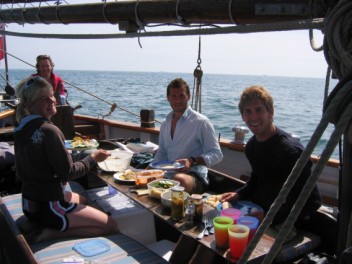
We arrive into Falmouth in time for Andy and Hart to catch their trains back to Exeter. Manoeuvring Lista around the harbour is not so easy. Conversely, spearing a few ‘yachties’ for a gentle donna kebab looks like child’s play. Hart and Andy balance on Lista’s sides, with rucksacks and fishing rod (reminiscent of Huckleberry Fin) ready to spring to land. With one leap they fling themselves over, leaving the ark far behind....... (Andy has since reported land sickness of the tenth degree, most unfortunate!)
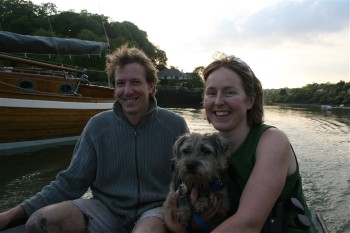
We slide towards Old Kea and Lista’s former home with our new crew mate Clare Lea. Lista lodged at Old Kea under the hawk eyes of our mates Jake Burnyeat and Martha Lea on her journey from Bristol to Exeter. They have pretty much done as much sailing on Lista as us, being our companions around much of the Devon and Cornwall coastline.
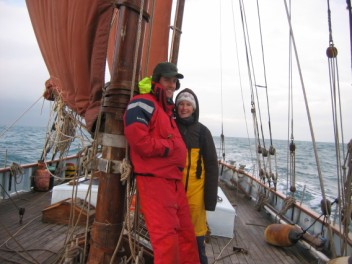
Jake spent a year after University sailing the mighty ‘Moonbeam’, a sleek 100ft gaff rig, through distant ocean passages. He has been our abiding almanac, with a steely belief in the term ‘ship shape’. Consequently, a new acronym has been sealed, WWJD, not the religious ditty “What would Jesus do” but rather ‘What would Jake do’ to guide us on all matters of nautical decision making on board! Should we just stuff it and leave the boat a tip in favour of a mad dash to dry land, cappuccinos, fine ale and a steady hand? WWJD? That’s right, untangle that jib halyard and topmast backstay and leave Lista Light looking venerable rather than an old knacker!
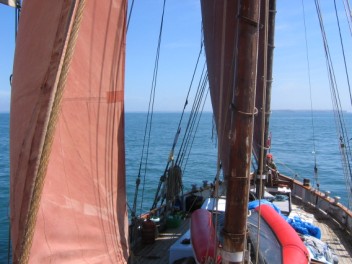
On to food- very important to a ‘Land’. The ‘fresh’ meat we have squirreled away has long been consumed, just before the point where it walked off of its own accord and our fishing prowess has also suffered since Andy’s departure. Additionally, Lowrie and my rather peculiar culinary manifestations are not to everyone’s sensibilities, particularly as Clare might have been born in Texas with her lust for steak, extra provisioning is the order of the day. To which ends, we have reliably been informed that M&S do the finest meat cans (80% meat).
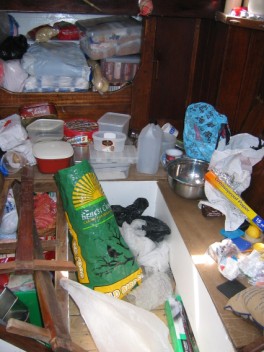
I need to add here (I’m sure it is mentioned elsewhere, but it’s vital to the proceedings) that Lowrie and I are consummate local food glutens. We avoid supermarkets wherever possible, clearly the meat tin thing is one such a slip, but M&S appear to stand as the superior players amongst a bad lot. Instead, we pound up and down streets to support local green grocers, butchers and health food shops.
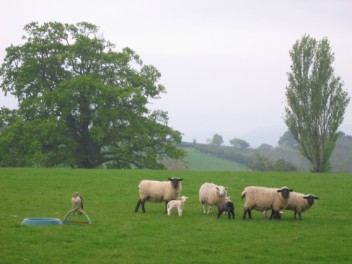
At home in fair ‘Debn’ we were lucky enough to live on Gray’s Cider Farm, across the fields from ‘Oak Farm Organics’ who sold us fine beef, lamb and pork cuts and up the hill from ‘Rod and Ben’s’ organic veg boxes. Kenn or Ide village shops are stacked with a rainbow of provisions and crucially open till late. We stacked our cycle panniers with provisions and ground up the hills to the ‘tin can’ - home.
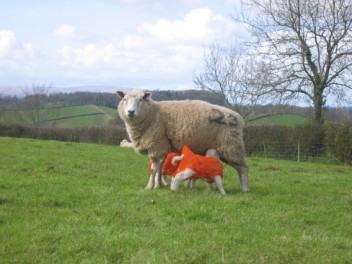
We tuck into a roast and prepare to leave Falmouth. On a high tide, a giant chunk of golden moon appears over the hills, simultaneously receding and growing before our eyes. We slip out of the Fal, following the buoys and the stars and heading for the Atlantic. Three hours on, three hours off, we coast through the night, with Lowrie overseeing us all and grabbing kips on the engine house whenever possible. I am useless as I peer into the gloom on my soulless watch with poor Savis. The sloshing, rocking motion and a stint below seals my fate, the roast meal appears for the second time in front of me......
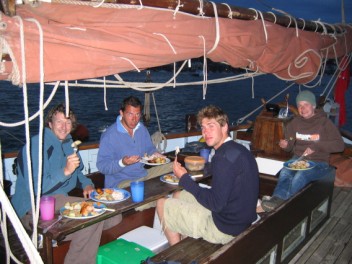
The weather continues to shine blue and golden. Hours peel by with a routine of watch, helming, cooking and washing up, spattered with entertainment from the Slaw-Savis double act.
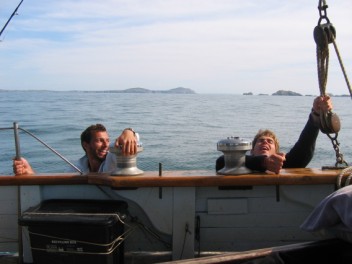
Then, ‘DOLPHINS’!! A pod of common dolphins streak between the bows and stern, weaving a foaming course by Lista’s side. We are far from land and they are our companions in the never-ending sea.
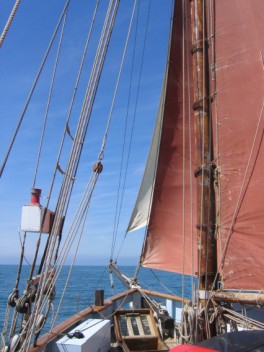
Common dolphins, as their name suggests are one of the commonest cetaceans with a global population estimated at several million. This does not, however, protect them from the threats of over-fishing and expanding fishing grounds.
Common dolphins have extremely variable white streaks and patterning on their bellies, prompting some scientists to hypothesise that they are different species. They range far out to sea where they feed on squid and small fish. They are highly active and amongst the fastest swimmers of all cetaceans, reaching up to 25 mph.
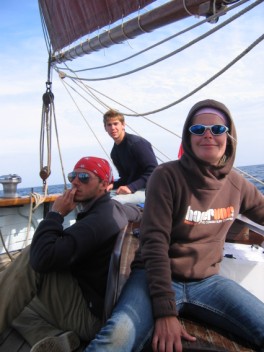
They keep returning to us during the day... we aren’t sure if they are the same group or new groups coming to check out the vast floating plank. It is bizarre how much pleasure we gain from them. Is it because Delphinus delphis is a mammal like the Homo sapien viewing it, producing an primeval affinity? Rattus rattus, however, is also a mammal, but I can’t recall people rushing to view it with excitement. Perhaps it is because we sight them so infrequently and when they do come it’s with friends to wheel and leap in an apparent playful exuberance.
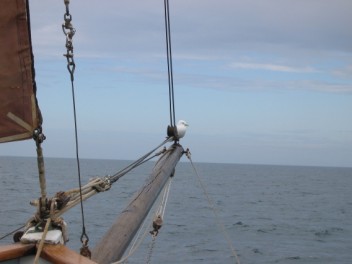
The bird life is growing thick like custard.... On our passage from the Exe we have been shadowed by ‘sea turkeys’, gannets; the sea bird colossus, fulmars; noses down, stiff winged, gliding through the sky and guillemots; rafting in cheerful bevies.
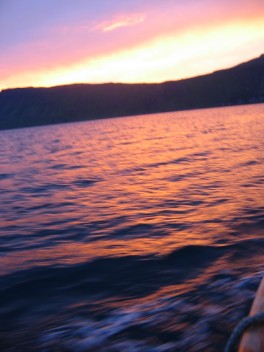
The northern gannet Morus bassanus is a truly incredible bird. Its cranium is reinforced allowing it to hit the water, from heights of up to 30m, at force as it dives for fish. Like pelicans, it has air sacs under its skin cushioning impact as it hits the water, while helping it bob back up to the surface with its prey. Its profile is streamlined, with narrow wings allowing it to glide over continental shelves as far south as the tropics.
Since rounding the Lizard Peninsular and Land’s End during the early hours of the night birdlife has really ratcheted up a notch...
A feeding frenzy churns in the sea in front of us. Gannets spear the water from dizzy heights, greater, lesser black-backed and herring gulls crash about in the surf lurching for fish, guillemots and manx shearwater plunge for the shoal. Gradually, the gurgling and frothing subsides and the predators dissipate.
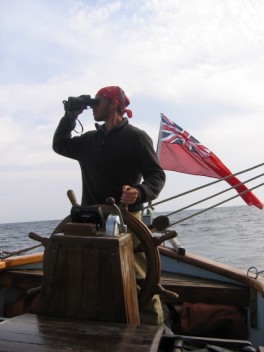
We head up towards the Irish Sea at a painfully slow 2.6 knots with the sails flapping in the pathetic breath of night. Tanker and ferries appear like menacing sentinels in the night. We desperately train the binoculars at them and try to decipher which way they are heading.
2am. Clare and I take our turn at night watch. Savis, Slaw and Lowrie are playing, ‘dump, marry or screw’, which is surprisingly helpful at staving off the night blues. They crawl into their bunks and we are left in the middle of nowhere. The wind buzzes through the tan sails, the boom creaks against the mast and the ropes tighten as we sway. It feels as if we are explorers from the pages of a musty history book, heading off to find new lands, spices and jewels.
We hear splashes. Dark forms grow closer, spectres rising from the seas. Dolphins. They’re back! A pod of at least eight common dolphins swim by our sides, gliding effortlessly through the wake of our bow. They remain with us for what feels like hours into the night, our friends in the deep black of nowhere. You can see how sailors could have mistaken them for mermaids, appearing from the abyss, with their dark, steam-lined figures, gusts of breath and high pitched sonar song.
We are rapidly working our way around our ‘Sea Areas’ tea towel which hangs above the galley table. We began at Portland, forged through Plymouth and have settled in Lundy.

Gannets flap irregularly past us, frequently in lines of four. I can understand that flying in synchronized lines allows maximum efficiency with each bird benefitting from one anothers back draft, like teams in the Tour de France. I don’t, however, understand why quadruple gannets? (Any ideas, on this or other matters, please email).
Puffins have nosed into the proceedings, in ones or twos, with their youngsters. The fledglings’ diminutive beaks and sooty feathering is most disarming when identifying.
Like puffins, manx shearwaters also nest underground in borrows or rock crevices. Lundy is a particular stronghold for the species. Predation by rats, particularly black rats over the years has, however, started to impact upon the population. After much consultation and with permission from Natural England, the RSPB began a removal programme. This year, surveys have indicated a dramatic recovery in the population.
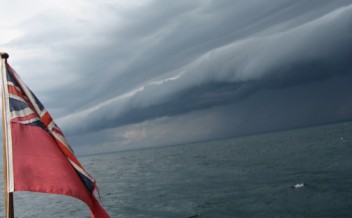
New Zealand is one of the forerunners in pest control for ecological grounds, as many of its native birds (there are no land mammals except bats) are threatened by introduced mammals which prey upon ground nesting birds. The birds (brown kiwi, kakakapo etc.) evolved without the predators that were introduced by man, so have no mechanism for survival against the new threats. Accordingly, many of the islands ringing New Zealand have become bird refuges, similar to Lundy.
As well as the predator control work carried out by the RSPB, Lundy has also benefited from becoming one of the first marine conservation areas in the UK. Fishing is banded within the marine zone which extends around the island to allow stocks to recover. A fish nursery has formed where fish fry (fish young) and young crustaceans such as lobsters are allowed to grow and mature. The RSPB and other environmental organisations are demanding a marine bill to provide more of these protected areas to allow fish stocks to recover. (More about this in the ecology section, when it arrives!)
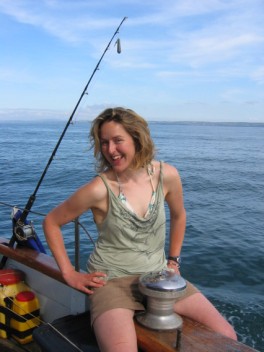
Then, all together unexpectedly, the dolphins are back. Ai, this is the third time I’ve mentioned the dolphins, a bit repetitive I know.... but this is something new, not just adults, but calves as well!!!!! Even old, jaded sea dog, cap’n’ Lowrie has never seen the like; a trio of adults with their wee young. They are the exact miniature replicas of their mothers (or fathers) glued to their sides, swimming at Lista’s bows. I glue the video camera to my eye and dart about the decks like a mad woman.
Then they are gone, with a flicker of their fins, they recede into the glinting distance. We grab the camera, not a sniff of a dolphin to be seen. I had pressed PAUSE......
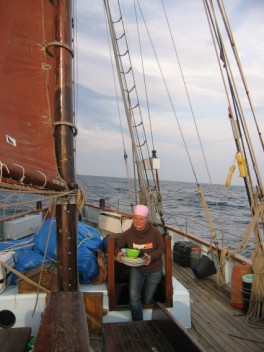
Milford Haven, late morning. We are expecting tankers, power stations, all the paraphernalia of the UK’s biggest port. We round the corner and find Dale Bay, quite a different vision. A quant fishing village nestles in the bay and we nose up against a pontoon. I fling myself onto the deck in peril of a scolding from cap’n’ for not hurling myself from at least 20ft to attach lines (he has infinite legs and believes all others have similar). I jar my already beaten up back (I had managed to get under a horse’s legs) and hop-along Cassidy style, crab step about securing ropes.
It is quickly appearing to me that the life of a mariner is tough. You can recognize one of the species by their rugged, weather-beaten hide, mottling of bruisers, stern brow, twitching chin measuring the bent of the sky, lack of teeth and bristled barnet. A fine look to evolve into.

Searing heat swathes the bay and other boats join our pontoon. We bask in the sun and dive off the boat.
A school of sailing pupils motor towards us. The instructor tows her brood in a long line behind her in their bath tubs. Not all of them are, however, so keen on striking off on their sailing careers. ‘I don’t want to Miss..., I’m scared.. I don’t like it...’ ensues. Reluctantly and pouting, a pair hover in their dingy and prod away from the pontoon, with ‘Miss’ bellowing instructions at them. ‘Tiller to the right, duck your heads, swap sides Lucy.....’ As they tack and the sails swing, gasps and wails scatter the bay. Eric takes his turn and gleefully strikes out into the distance, with sails blazing. Effortlessly, he manoeuvres turns and glides around the bay, with Miss cooing praise to the wind. The girls glower, crossed-legged on the pontoon.
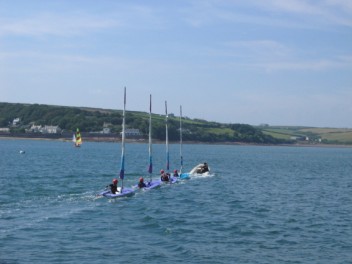
Sailing again, Savis and Slaw stand proud at the bowsprit and do their sultry, Titanic impersonation as we plunge through the waves....’Oh dear Savis you mean the world to me....oh Slaw..our love will go on and on and on and on!.....’
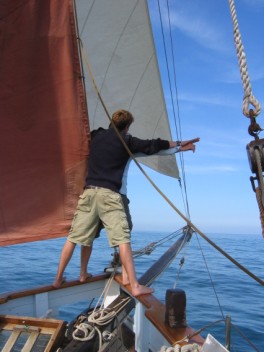
A beautiful Pembrokeshire coast passes us, pocked with islands and heaving with wildlife. More dolphins join us as do guillemots and a motley crew of flying companions.
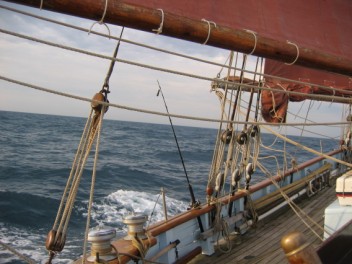
Finally, in the early evening we coast into Fishguard bay and drop anchor. We grab a bevvy to celebrate..... but it all unravels rather rapidly as the gin is replaced by the pirate’s rum, swiftly followed by a short lived appearance of the whisky and ......deterioration..... ‘What shall we do with the drunkard sailors?’
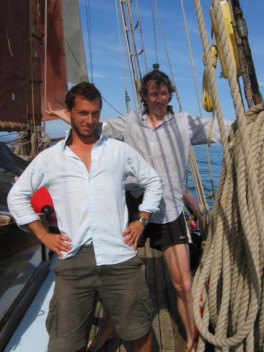
I am determined to serve the potato-canned meat (odour of Pedigree Chum) concoction that has been brewing for some hours with occasional hiccupping attention. Incredibly, we do manage a mouthful before the evening merges into dusk. Clare disappears below and is found later passed out on her bunk. I suddenly feel the world is rounding on me and dive for the heads to deposit an offering to the dunny.
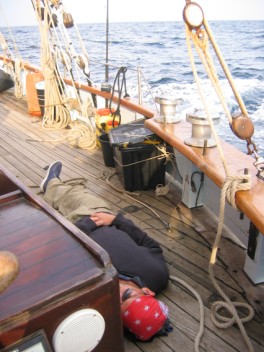
Signs of departure are rattling around the boat. Savis and Slaw look set on going. They eye each ferry docking at Fishguard and their disembarking quarry with intent. They have prepared their paper signs for unsuspecting motorists to deploy them home. We all clamber into the dingy and finally reach the pier to see streams of cars disappearing out of range. The guys recede into the distance, two over laden rucksacks and ripples of laughter.......
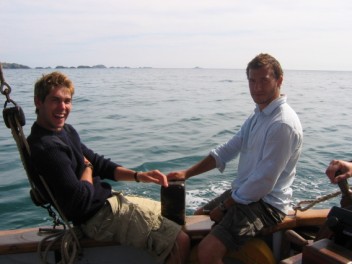
Forward to next section - Fishguard (Wales) to Isle of Jura (Scoland)
This page hit Count : 11808
This is the Lista Light Website, for the travels of the sailing boat Lista Light
Click here for text-version of site